Vizsla Breed Guide
This breed has many names – Hungarian Vizsla, Hungarian Pointer, Maygyar Vizsla – but they all add up to one beautiful dog. Although the Vizsla is a great all-around pointer and retriever, he is also a fabulous companion and family dog.
What does the Vizsla look like?
One of the characteristics that has made the Vizsla immensely popular is his small size. Weighing in at 40 – 65 pounds and standing 21 – 25 inches tall, the Vizsla is one of the smaller sporting breeds. His distinctive rust-colored coat is short and smooth, with no undercoat. His nose color should blend with his coat, as should his light-colored eyes, which are usually green or blue. The eye-rims, lips, toenails, and pads of the feet are also close to the same color as the coat.
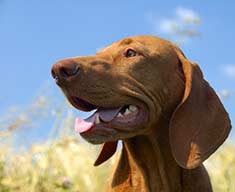
The dog’s coat color may range from copper to russet gold to dark sandy gold, but solid dark mahogany and pale yellow are considered faults. A small white patch on the chest is permissible, but it must not extend onto the shoulders or neck.
This dog is so energetic, it is tough to keep weight on him. Being able to see the stark outline of the ribs, hipbones, and spine is considered normal in this dog. As the dog ages and becomes less active, his food rations should be adjusted accordingly to keep him from becoming obese.
There has been some controversy about tail-docking in recent years, with many critics decrying the procedure as unnecessary and barbaric. However, certain breeds require tail docking to prevent damage to the tail, and the Vizsla’s tail should be routinely docked before the puppy reaches 3 days of age.
Two-thirds of the Vizsla’s tail is strong and thick, but the last one-third of the tail is very thin and whip-like. As the dog runs after its prey, he wags his tail vigorously, leaving it susceptible to splitting and bleeding. Once the tail is damaged, it often does not heal appropriately and may eventually have to be amputated. At the very young age when most Vizslas are docked, the nerve structure to the tail is not yet developed, and the procedure does not cause undue pain.
How does the Vizsla act?
This highly affectionate dog often appears to have Velcro attached to him, as he rarely leaves his guardian’s side. In fact, if permitted to get away with it, he will sleep in bed with his guardians, preferring to be under the covers because his short single coat does not offer much protection from the cold.
Vizslas have an intense high-energy drive and require lots of regular exercise. This dog runs like the wind and will not be happy without the opportunity to stretch his muscles daily.
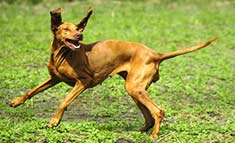
The Vizsla is a natural hunter and relatively easy to train using positive reinforcement such as praise and treats. This breed is very sensitive and will not take well to harsh training. Vizslas work equally well on land and sea, serving both as pointers and as retrievers.
Highly intelligent, the Vizsla needs mental stimulation as well as physical. If he doesn’t have a challenge, he may become depressed or obsessive-compulsive. An obsessive-compulsive dog may continually lick himself causing sores to develop. The Vizsla enjoys constant companionship, and may become destructive if left alone for long periods of time.
A good way to keep your Vizsla occupied and provide him with the companionship he craves is to get him involved with dog sports such as agility, lure coursing, dock diving, or flyball.
What are the grooming requirements for a Vizsla?
The Vizsla is a very low-maintenance dog. He does not pick up dog odor, unless he goes swimming after birds fairly often. Bathing once every three to six months is generally sufficient unless he rolls in something fragrant while out on a run. His short coat requires very little brushing. This breed does shed, but not excessively. Rubbing the dog with a sweater made of synthetic fibers will pick up loose hairs and prevent them from landing on your furniture.
How was the Vizsla breed developed?
The Vizsla’s ancestors were depicted in primitive stone etchings over a thousand years ago, shown with Magyar hunters, and was described in a written work as early as 1357. Originally reserved only for the ruling class, they were prized for their hunting ability and companionship.
As the Austria-Hungary empire was carved up into smaller republics, Vizslas found themselves living in many parts of Eastern Europe, even though they all share Hungarian ancestry. After near extinction at the end of World War II, the dozen or so pure-bred specimens were carefully bred to further the standard we see today. The breed was brought to the United States in the early 1950s and was recognized by the American Kennel Club in 1960.
Where have I seen this breed?
The Vizsla has never been among the most popular breeds in the United States, ranking at number 44 on the AKC’s list of 161 breeds. The breed is much sought-after as a gun dog, but his high energy requirements scare many prospective guardians. Clifford the Big Red Dog is perhaps the most notable member of the breed, although a giant one, at that.
The Vizsla has been used in development of several other breeds including the Weimaraner, the Wire-haired Vizsla, and the German Shorthair Pointer, resulting in a strong resemblance between these breeds.
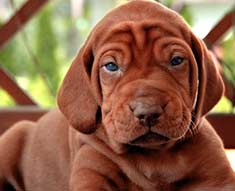
Is this the dog for me?
You will not likely find a dog that likes to cuddle more than the Vizsla. If your lap can handle a 50-pound load, this is the dog that will keep you warm when you sit, crawl under the covers with you at night, and follow you from room to room throughout the day. However, his high energy needs dictate that he must get at least 30 minutes of big-muscle exercise each and every day. If you have a large yard, it will be sufficient to allow him to romp there. However, if you don’t have the luxury of green space at your home, you must find a dog park or some other place where your Vizsla can run freely off-leash.
If you can support his high-energy needs, or if you need an outstanding gun dog, the Vizsla may well be the dog you are looking for.
Doggies Den: Latest Articles
 Homemade Thanksgiving Treats for Your Dog
Homemade Thanksgiving Treats for Your Dog
NUTRITION We all want to include our dogs in our holiday celebrations, but hopefully, you're aware that sharing table scraps with your dog isn't always the best idea.
 Keeping Your Dog Safe during the Summer Months
Keeping Your Dog Safe during the Summer Months
HEALTH Summer is coming on fast, so it’s time to plan how you will keep your dog safe and healthy through the lazy, carefree, warm days.
 Vaccination Time Again-Keeping Your Puppy Healthy
Vaccination Time Again-Keeping Your Puppy Healthy
DOG HEALTH So you have your new puppy picked out. There are quite a few shots, treatments and examinations that will keep the newest member of your family healthy.
 Canine Thanksgiving Feast
Canine Thanksgiving Feast
NUTRITION With the wide variety of food at Thanksgiving dinner, chances are you'll want to give your dog something special, too. If you're contemplating what to feed your dog for the holiday, here is a guide to a great Canine Thanksgiving Feast.
 Dog Walking Tips Every Owner Should Know
Dog Walking Tips Every Owner Should Know
DOG FUN Walking your dog is not only crucial to keeping him healthy and happy, it strengthens the bond between your canine friend and his caregiver. There are a lot of obstacles out there. Don’t forget these simple tips to keep your walk fun and safe in the outside world.
 The Benefits of Physiotherapy for your Dog
The Benefits of Physiotherapy for your Dog
HEALTH The same techniques that physiotherapists use to treat a variety of injuries and conditions in humans have been adapted to suit animals with great success. Family pets, show dogs, and working dogs can all benefit greatly from physiotherapy. Dogs whose activities involve a lot of agility are especially susceptible to the types of problems that physiotherapy can address.
 The Decision- Adding a Dog to Your Family
The Decision- Adding a Dog to Your Family
FIRST TIME OWNERSBringing a dog into your family is a decision where many people don’t realize it’s magnitude until after they have the dog. There are a number of things that you need to research before you decide to purchase a dog, and it starts right in your own home.
 Bringing Your Dog Into Your New Baby's Life
Bringing Your Dog Into Your New Baby's Life
HEALTH Many believe that a dog and a new baby cannot happily coexist, so therefore the dog has to go. This is not necessarily the case.  A new baby does not mean you have to abandon your dog.

Doggies Den:
Most Popular Articles

Dog Pregnancy Symptoms
HEALTHIf you suspect your dog might be pregnant, check out part one in this series on pregnant dogs, where we cover pregnant dog symptoms.
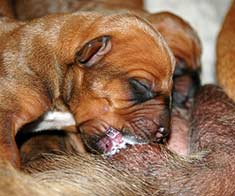
Dog Birth
HEALTHIn the third article of our dog pregnancy series, we look at the wonderful, but messy, process of bringing newborn puppies into the world.

Indoor Dog Potties
DOG PRODUCTSIt's been a long day at work. You were so busy, you didn't even take time to eat a sandwich, let alone run home to let your dog out. You're on your way home, knowing the poor dog is crossing his or her legs by now, when your car breaks down, delaying you even further. Can't somebody make this easier?
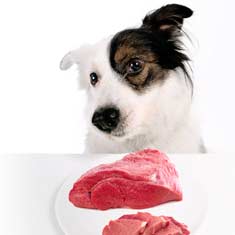
Your Dog’s Digestive System
PHYSIOLOGYEver wonder why your dog eats so fast? Or why he eats gross things? Or why he gets sick to his stomach? Or why his waste stinks so bad? Some of these things are normal, some are not.

Canine Respiratory System
BREATHINGThe basic function of your dog's respiratory system is to bring oxygen in to and remove carbon dioxide from the body. Knowing the symptoms of respiratory diseases can help you help your stay healthy.
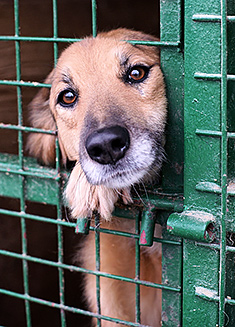
Shelter Dog Adoption Tips for Success
ADOPTION Are you intimidated by the prospect of "rescuing" a dog from a shelter? One reason that you may be wary of adopting a dog from a shelter is not knowing how to choose. Adopting a dog from a shelter can be a rewarding process, if you're prepared to do a reasonable amount of research.

Canine Urinary Tract Infections
SYMPTOMS AND TREATMENTDoes your dog seem to be having trouble relieving his or her bladder? Learn how to recognize the signs of urinary tract infections and how to treat them before they spread.

What to do for Dog Diarrhea
SYMPTOMS AND REMEDIESIf you have dogs in your house for any length of time, you have likely experienced at least one bout of dog diarrhea. Beyond the pain in the tuckus involved in cleaning up the mess, you should know what causes diarrhea, and when it's important to see the vet.
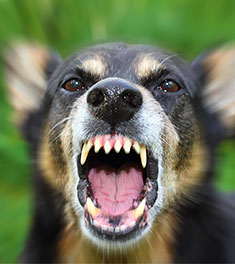
What to do for a Dog Bite
DOG BEHAVIOR Getting bitten by a dog can be scary, and you may be tempted to run around in circles for a while, trying to figure out what to do. Here's our guide to help you manage the situation.

Top Ten Tips for Living with a Senior Dog
DOG HEALTH Bringing home a new puppy is so exciting, but it doesn’t take all that long for your exuberant puppy to grow into a senior dog who may have special needs. Here are the doggies.com top ten tips for taking care of your companion who has been with you through so much.
